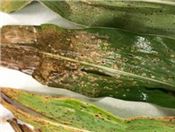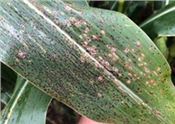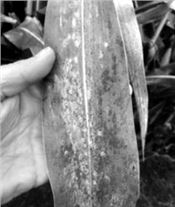|
Tar Spot In Corn – Requesting Your Help
DR. NATHAN KLECZEWSKI
URBANA, ILL.
Tar spot is a relatively new disease in corn. It was first described in Illinois and Indiana in 2015, and was first located near DeKalb. Tar spot has been detected to some degree in Northern Illinois each year since. However, typically infections are sparse and the disease does not come in until later in the season. Consequently, yield loss due to this disease has been minimal, and the disease mostly considered an oddity.
However, in parts of Latin America, where the disease is known as Tar Spot Complex, severe yield losses can occur. In this case, two pathogens are involved. One fungus produces the black tar spots we typically see, and another produces toxins that can cause varying degrees of foliar blight and necrosis. Our colleagues at CIMMYT in Mexico are currently working on identifying the toxins involved and how they may relate to virulence. It is important to note that there is very little known about tar spot complex, how the pathogens interact with oneanother, the epidemiology of the disease, and how the pathogens interact with their corn host. In addition, it is possible that this disease may act differently in Midwest production systems, as hybrid genetics, production practices, and environments differ from those in Latin America.
This season we have seen this disease take off in Northern Illinois, as well as Southern Wisconsin, Michigan, and parts of Indiana. Symptoms vary from from the traditional black raised bumps, to bumps with necrotic fisheye lesions, to spots on leaves that blight and drydown. Some fields have light infection, whereas others have over 30 percent leaf severity through the highest leaf of the hybrid. Early this summer, prior to this outbreak, we started working with colleagues in other states and CIMMYT to better understand the tar spot pathogens and improve our abilities to detect and manage this disease if needed. One item that we need for this project are samples. If you have fields with symptoms of tar spot, particularly those with necrosis associated with the lesions, please send care of Dianne Plewa at the University of Illinois Plant Disease Clinic. The website with address and contact information is located at the following address:
https://web.extension.illinois.edu/plantclinic/ Please include the county of origin, if a fungicide was applied, and the hybrid, if possible.
In addition, we are working to assess potential variety response and yield impacts of this disease. If you would like to participate in the effort, please contact me at 217-300-3253 or email me at nathank@illinois.edu. I also can be reached on Twitter @ILplantdoc. ∆
DR. NATHAN KLECZEWSKI: Extension Plant Pathologist, University of Ilinois
Tar Spot on corn with Black raised “bumps” and small necrotic fisheye symptoms.
N Kleczewski and J Donnelly



|
|